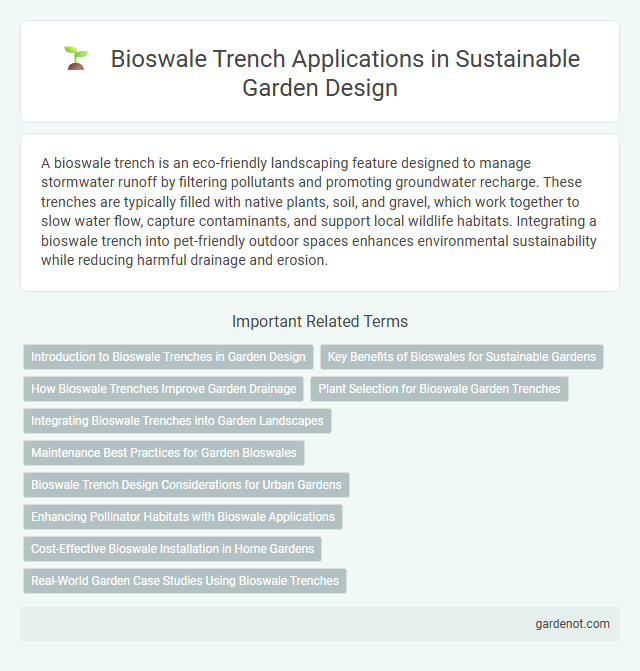A bioswale trench is an eco-friendly landscaping feature designed to manage stormwater runoff by filtering pollutants and promoting groundwater recharge. These trenches are typically filled with native plants, soil, and gravel, which work together to slow water flow, capture contaminants, and support local wildlife habitats. Integrating a bioswale trench into pet-friendly outdoor spaces enhances environmental sustainability while reducing harmful drainage and erosion.
Introduction to Bioswale Trenches in Garden Design
Bioswale trenches are engineered landscape features designed to manage stormwater runoff by filtering pollutants through layers of soil, sand, and vegetation. In garden design, these trenches promote sustainable water management by facilitating groundwater recharge and reducing erosion. Integrating native plants within bioswale trenches enhances biodiversity while improving water quality and aesthetic appeal.
Key Benefits of Bioswales for Sustainable Gardens
Bioswale trenches effectively manage stormwater runoff by filtering pollutants and promoting groundwater recharge, enhancing water quality in sustainable gardens. These vegetated channels reduce soil erosion and prevent flooding by slowing water flow and increasing infiltration rates. Incorporating bioswale trenches supports biodiversity, improves soil health, and reduces reliance on traditional irrigation systems, making gardens more resilient and eco-friendly.
How Bioswale Trenches Improve Garden Drainage
Bioswale trenches enhance garden drainage by capturing and directing stormwater runoff into permeable soil layers, reducing surface water accumulation and erosion. These trenches use engineered soil mixtures and vegetation to filter pollutants while promoting groundwater recharge, improving overall soil health. Effective bioswale designs prevent waterlogging and support sustainable water management in landscape gardens.
Plant Selection for Bioswale Garden Trenches
Selecting native and drought-tolerant plants for bioswale garden trenches enhances water filtration and soil stabilization while reducing maintenance requirements. Deep-rooted species such as sedges, rushes, and blue flag iris improve infiltration rates and prevent erosion by promoting soil structure integrity. Incorporating a diverse mix of grasses, wildflowers, and shrubs tailored to local climates increases pollutant removal efficiency and supports urban biodiversity.
Integrating Bioswale Trenches into Garden Landscapes
Bioswale trenches effectively manage stormwater by filtering pollutants through native plants and engineered soil, enhancing garden sustainability. Integrating bioswale trenches into garden landscapes improves water infiltration and reduces runoff, promoting healthy soil and vibrant plant growth. Strategic placement along garden contours maximizes water capture and supports local ecosystems with minimal maintenance.
Maintenance Best Practices for Garden Bioswales
Regularly inspecting a bioswale trench ensures debris and sediment buildup do not impede water flow, maintaining optimal drainage and filtration. Routine removal of invasive weeds and replanting native vegetation supports soil stabilization and enhances pollutant removal efficiency. Seasonal monitoring of soil moisture and trench integrity prevents erosion and promotes sustained bioswale performance in garden landscapes.
Bioswale Trench Design Considerations for Urban Gardens
Bioswale trench design in urban gardens requires careful consideration of soil permeability, trench depth, and slope to maximize stormwater infiltration and pollutant removal. Incorporating native vegetation with deep root systems enhances soil stability and microbial activity, improving water quality management. Proper trench lining and overflow outlets prevent erosion and waterlogging, ensuring efficient drainage and long-term sustainability.
Enhancing Pollinator Habitats with Bioswale Applications
Bioswale trenches effectively enhance pollinator habitats by integrating native flowering plants that provide essential nectar and pollen resources, promoting biodiversity within urban and agricultural landscapes. These vegetated troughs improve water infiltration and filtration, supporting healthy soil and plant growth crucial for pollinator sustenance. Incorporating bioswale trenches into green infrastructure fosters resilient ecosystems that sustain bee, butterfly, and other beneficial insect populations.
Cost-Effective Bioswale Installation in Home Gardens
Bioswale trenches offer a cost-effective solution for managing stormwater runoff in home gardens by reducing soil erosion and improving groundwater recharge. Installation involves digging shallow, vegetated channels that require minimal materials, significantly lowering expenses compared to traditional drainage systems. Homeowners benefit from reduced water bills and enhanced garden health through natural filtration and efficient water absorption.
Real-World Garden Case Studies Using Bioswale Trenches
Bioswale trenches demonstrate effective stormwater management in urban gardens by filtering runoff through layered soil and vegetation, reducing pollutants and erosion. Real-world cases, like Seattle's University of Washington Campus, showcase how bioswale trenches improve water quality while enhancing green space aesthetics. These installations contribute to sustainable garden design by promoting groundwater recharge and supporting native plant biodiversity.
Bioswale trench Infographic

 gardenot.com
gardenot.com